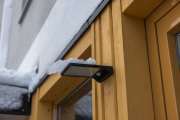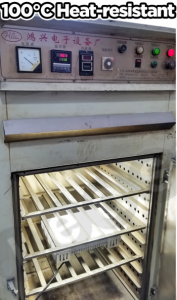The Meaning of Limit Parameters
- Allowable power consumption Pm: The maximum value of the product of the positive DC voltage and the current flowing through it. If this value is exceeded, the LED will heat up and be damaged.
- Maximum forward direct current IFm: the maximum allowable forward direct current. Exceeding this value can damage the diode.
- Maximum reverse voltage VRm: the maximum allowable reverse voltage. Above this value, the LED may be damaged by breakdown. The maximum continuous forward current (IF) and derating curve or derating factor at 25℃ environment or tube base temperature. Where appropriate, under specified pulse conditions, the maximum peak forward current (IFM) at 25°C environment or tube base temperature
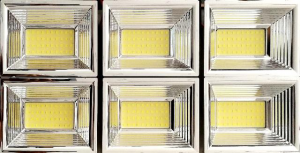
- Working environment topm: the ambient temperature range where the light-emitting diode can work normally. Below or above this temperature range, the light-emitting diode will not work normally and the efficiency will be greatly reduced.
The meaning of electrical and optical parameters
- Spectral distribution and peak wavelength and test:
The light emitted by a certain light-emitting diode is not a single wavelength, and its wavelength is roughly as follows.
The light intensity of a certain wavelength λ0 in the light emitted by the luminous tube is the largest, and this wavelength is the peak wavelength.
Test purpose: To measure the peak emission wavelength, spectral radiation bandwidth and spectral power distribution of the tested LED device under the specified forward working current.
Test elements:
LED device under test,
Battery,
Focusing lens system,
Current source (DC or pulse),
Eliminate the stray light barrier,
monochromator,
Radiation detection system including diaphragm.
Note: The wavelength resolution and bandwidth of the monochromator should enable the test to have suitable accuracy. The spectral response of the radiation detection system should be calibrated. To facilitate measurement, the peak value of the curve can be expressed as 100%. If the spectral transmittance of the monochromator and the spectral sensitivity of the radiation detection system are not constant, the recorded measurement data should be corrected.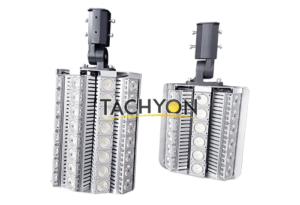
Test steps:
Adjust the wavelength of the monochromator within the required spectral range until the radiation measurement system obtains the maximum reading, the corresponding wavelength is the peak wavelength (λp), and then adjust the wavelength of the monochromator to the two sides of λp until half of the peak wavelength reading is obtained. Corresponding wavelength λ1 and λ2, the difference between the two is the spectral radiation bandwidth.
Measure and record the spectral power value of each wavelength separately according to the required wavelength interval, which is the spectral power distribution.
Stipulated conditions
Environment and pipe base temperature;
The specified forward current (DC or pulse).
- Luminous intensity IV and test:
The luminous intensity of a light-emitting diode usually refers to the luminous intensity in the direction of the normal line (for a cylindrical luminous tube, the axis). If the radiation intensity in this direction is (1/683) W/sr, 1 candela will be emitted (symbol is cd). Since the luminous intensity of general LEDs is small, the luminous intensity is often used as the unit of candela (mcd).
Test purpose: To measure the average LED intensity of semiconductor light-emitting diodes.
Test points
LED device under test,
Battery,
Including a photometric detector with a diaphragm D1 of area A,
Eliminate the stray light barrier, should not limit the detection of solid angle,
The distance between the tested LED device and the diaphragm.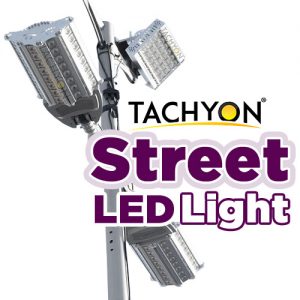
Note 1: Adjust the LED device under test so that its mechanical axis passes through the center of the detector aperture.
Note 2: The spectral sensitivity of the photometric detector should be calibrated to the CIE (International Commission on Illumination) standard photometric observer spectrum curve within the spectrum wavelength range emitted by the device under test; a photodetector without spectral selectivity should be used when testing radiation parameters. The test system should be calibrated with a standard according to the distance d and the diaphragm D1. The measuring distance d should be set according to the standard conditions A and B recommended by CIE. Under these two conditions, the detector used requires a circular entrance aperture with an area of 100mm2 (corresponding to a diameter of 11.3mm).
Note 3: For pulse measurement, the current source should provide current pulses of the required amplitude, width and repetition rate. The rise time of the detector should be small enough relative to the pulse width, and the system should be a peak measuring instrument.
Test steps:
The LED device under test is positioned according to the selected form and the specified current is applied to the device under test, and the average LED intensity is measured in the photometric measurement system.
Requirements:
Ambient temperature and suitable atmospheric conditions,
Forward current and, if necessary, width and repetition rate.
- Spectral half-width Δλ:
It represents the spectral purity of the luminous tube. It refers to the interval between two wavelengths corresponding to 1/2 peak intensity.
- Half-value angle θ1/2 and viewing angle and test:
θ1/2 refers to the angle between the direction where the luminous intensity value is half the axial intensity value and the luminous axis (normal direction). Two times the half-value angle is the viewing angle (or half-power angle).
The angular distribution of the luminous intensity of two different models of LEDs is given. The coordinate of the vertical line (normal) AO is the relative luminous intensity.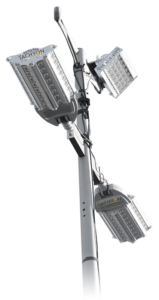
(That is, the ratio of the luminous intensity to the maximum luminous intensity). Obviously, the relative luminous intensity in the normal direction is 1, and the greater the angle away from the normal direction, the smaller the relative luminous intensity. From this, the half-value angle or viewing angle value can be obtained.
Testing purposes:
Measure the spatial distribution and half-maximum intensity angle and deviation angle of the average LED intensity of the semiconductor light-emitting diode under the specified operating current. The half-intensity angle θ1/2 is the angle formed by the luminous (or radiation) intensity greater than or equal to half of the maximum intensity (see Figure 8). In the average LED intensity distribution graph, the maximum intensity direction (optical axis) and the mechanical axis Z are clamped The angle is the deviation angle Δθ.
Test elements
LED device under test,
Battery,
Including a photometric detector with a diaphragm D1 of area A,
Eliminate the stray light barrier, should not limit the detection of solid angle,
The distance between the tested LED device and the diaphragm,
The angle between the Z axis and the detector axis.
Note 1: The distance d should be set to CIE standard condition A or B,
Note 2: For pulse measurement, the current source should provide current pulses with the required amplitude, width and repetition rate. The rise time of the detector should be small enough relative to the pulse width. The system should be a peak measuring instrument.
Note 3: The tested LED is positioned on a device (for example: the rotation center is located on the angle dial on the optical axis of the system, the dial should have sufficient angle scale accuracy),
Claim:
–The position of the tested LED device can be accurately reproduced,
–Change the angle θ, the center of the optical window of device D can be kept fixed, –Can measure the included angle θ;
–Can rotate around the Z axis of the device under test, –Can measure the rotation angle about the X axis.
Test steps:
- a) Add the specified operating current to the device under test. Adjust the mechanical axis of the device under test D to coincide with the axis of the optical detector, that is θ = 0, measure the signal of the optical detector, and set this value to I0 = 100%,
- b) From the 0-±90° rotating dial, the photoelectric measuring system measures the luminous intensity value at various angles, and obtains the relationship between the relative intensity I /I0 and θ. The polar coordinate diagram is preferred, and other forms, such as right angles Coordinate chart can be used after being defined in the blank detail specification. Read the angle θ1 θ2 corresponding to the half-maximum intensity point on the graph, and the half-intensity angle Δθ=|θ2 -θ1 |. The deviation angle is the angle between the Imax and I0 directions.

Requirements:
Environment and pipe base temperature,
Specify forward current IF or radiated power Φe, mechanical reference plane.
- Optical axis:
The center line of the direction of maximum luminous (or radiation) intensity.
- Forward Current IF (Forward Current):
It refers to the forward current value when the light-emitting diode normally emits light. In actual use, you should choose IF below 0.6²IFm according to your needs. IF = (U-VF) / R (U— is the supply voltage, R— is the current-limiting resistance.)
- Forward voltage VF (Forward voltage) and test:
When the forward current through the light emitting diode is a certain value, the voltage drop generated between the two poles. The operating voltage given in the parameter table is obtained under a given forward current. It is generally measured when IF=20mA. The forward working voltage VF of the light emitting diode is 1.4~3V. When the outside temperature rises, VF will drop. Circuit design should avoid pulse high voltage in the loop.
Testing purposes:
Measure the voltage drop between the two electrodes of the LED device under the specified forward working current. Check whether the LED is glowing and its color.
Test elements:
LED device under test,
A constant current source,
Ammeter,
Voltmeter.
Test steps
- a) Connect the test system according to the electrical principle and preheat the instrument,
- b) Adjust the constant current source to make the ammeter reading the specified value. At this time, the reading on the DC voltmeter is the forward voltage of the device under test. DC5V power supply +330Ω resistance.
Stipulated conditions
Ambient or pipe base temperature,
voltage,
Forward bias current.
- Reverse voltage VR (Reverse voltage) and test:
When the reverse current passed by the tested LED device is a certain value, the voltage drop generated between the two poles.
Testing purposes:
Measure the reverse voltage generated between the two electrodes when the reverse current through the LED device is a specified value.
Test elements
LED device under test,
Voltage source,
Ammeter,
Voltmeter.
Test steps
- a) Connect the test system according to the electrical principle and warm up the instrument.
- b) Adjust the stabilized voltage supply to make the ammeter read the specified value. At this time, the reading on the DC voltmeter is the reverse voltage of the device under test. Measure the reverse current generated when the specified reverse voltage is applied to the LED device under test.
- Reverse current IR (Reverse current) and test:
When the reverse voltage applied to both ends of the light emitting diode is a certain value, the current flowing through the light emitting diode.
Testing purposes:
Measure the reverse current generated between the two electrodes when the forward voltage passing through the LED device is a specified value.
Test elements
LED device under test,
Voltage source,
Ammeter,
Voltmeter.
Test steps
- a) Connect the test system according to the electrical principle and warm up the instrument.
- b) Adjust the regulated power supply to make the voltmeter read the specified value. At this time, the reading on the DC ammeter is the reverse current of the device under test.
Stipulated conditions
Ambient or pipe base temperature,
voltage,
Reverse current.
- V-I characteristics:
The relationship between the voltage and current of the light-emitting diode is as follows:
When the forward voltage is less than a certain value (called the threshold), the current is extremely small and no light is emitted. When the voltage exceeds a certain value, the forward current increases rapidly with the voltage and emits light. From the V-I curve, the forward voltage, reverse current and reverse voltage of the LED can be obtained. The forward luminous tube has reverse leakage current IR.
- Total capacitance C (Capacitance) and test:
The capacitance at both ends of the light-emitting diode under the specified forward bias and the specified frequency.
Test purpose: to measure the capacitance value at both ends of the device under test when the specified forward bias voltage and signal of the specified frequency are applied to the tested LED device.
Test elements:
LED device under test,
Isolation capacitor,
Ammeter,
Voltmeter,
inductance.
Test steps
- a) Connect the test system according to electrical principles and warm up the instrument;
- b) Adjust the voltage source and adjust the capacitance meter, respectively apply the specified forward bias voltage and the specified frequency signal to the tested LED device, deduct the capacitance C0 from the reading on the capacitance meter scale, and the equivalent value is the total measured LED device Capacitance value.
Stipulated conditions
Ambient or pipe base temperature,
Forward bias voltage,
The capacitance meter provides a signal of a specified frequency.
- Switching time and test:
The minimum and maximum specified values involving the following concepts are 10% and 90%, unless otherwise specified.
Testing purposes:
Measure the turn-on time ton (turn-on delay time td(on) + rise time tr) and turn-off time toff (turn off delay time td(off) + fall time tr) of the tested LED device.
Test elements
LED device under test,
High resistance current pulse generator,
DC current bias power supply,
DC voltage bias power supply,
Resistance matching the generator impedance,
Load Resistance,
measuring instrument,
Photodiode,
Sync signal.
Note: The switching time of the photodiode, the delay time of the experimental circuit and the measuring instrument, and the rise time and fall time of the input current pulse should be short enough to ensure that the measurement accuracy is not affected. The average output power obtained at the top of the optical pulse is not necessarily equal to the continuous radiant power when the sum of the DC bias current and the input pulse current.
Measurement procedure
Apply the specified DC and pulse current to the device under test, and measure the switching time with the measuring instrument M. The 100% radiation output power level is the average output power obtained at the top of the radiation pulse. The 0% level is the output power at DC bias current.
Stipulated conditions
Environment and pipe base temperature,
DC bias current,
Optical window,
Optical structure.




